If a tree falls in a city
Dec 20, 2009

The poor bicycle, chained to a pole, had no chance to escape. But at least nobody was riding it at the time.
Photo by Sam Javanrouh in Toronto.
Dec 20, 2009

The poor bicycle, chained to a pole, had no chance to escape. But at least nobody was riding it at the time.
Photo by Sam Javanrouh in Toronto.
Jan 17, 2010
The old Eastland Hotel in downtown Portland has a lot of windows and a lot of bricks.
Aug 25, 2011
 Sadly, this is a "before" picture: the big American Elm tree in the courtyard of Shiloh Baptist Church in our neighborhood has been diagnosed with Dutch Elm Disease and is about to be cut down.
Sadly, this is a "before" picture: the big American Elm tree in the courtyard of Shiloh Baptist Church in our neighborhood has been diagnosed with Dutch Elm Disease and is about to be cut down.
I'm told this tree made a cameo appearance in The Sixth Sense, a Bruce Willis movie shot in the neighborhood, but I can't confirm or deny. There's a pivotal scene near the end of the movie in which the boy and his mother sit talking in the car, which is stopped near the scene of an accident; there's a tree outside the car window on the boy's side, but all the camera shows of this tree is its lower trunk, which is not sufficient for a positive ID.
Anyway, the church building and probably also the tree date back to the 1860s, when the Church of the Holy Apostles was built to serve a neighborhood rapidly filling with immigrants from Ireland. Numerous annexes and additions were required, as the parish exceeded 10,000 by 1910. But by 1940, descendants of the Irish immigrants were leaving the neighborhood, and descendants of African slaves from the American South were pouring in. The church complex was sold to a Baptist congregation and renamed Shiloh.
Today, Shiloh's congregants have mostly left the neighborhood, replaced this time by newcomers who mostly grew up in middle-class suburbs; one long-time resident described the new neighbors to a newspaper reporter as "white people with big dogs." Churchgoers who've moved away return to Shiloh on Sunday mornings, causing traffic jams and parking conflicts. There is no church parking lot; for the church's first hundred-plus years, people got there by walking.
The congregation is shrinking fast and is already far too small to maintain the huge church complex. The elm will come down in the next few weeks; the building, designed by the iconic Philadelphia architect Frank Furness, may not be far behind.
Dec 8, 2011
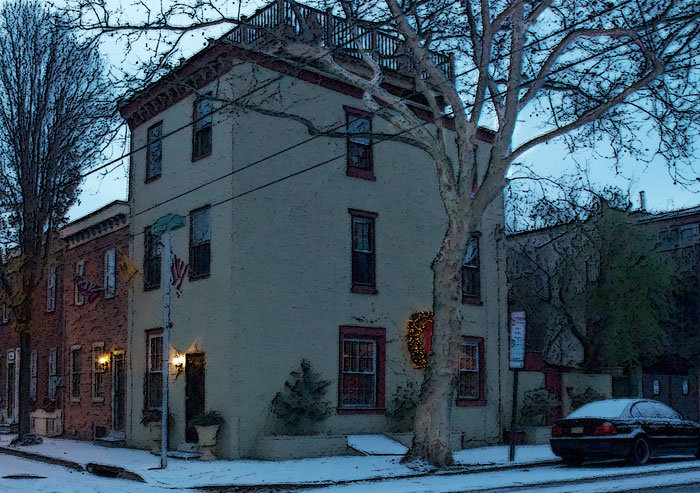 I always thought they were called sycamores, but no, the people who know these things tell me that city trees that look like sycamores are actually hybrid variants called London planes. Real sycamores, we are told, are too crooked to serve well as street trees, so things are what they are, and now that the old elm trees are no longer among us, we are left with London planes as kings of the sidewalks, with their fine white bark and annoying seed balls. This one is on South 21st Street in Philadelphia, near the corner of Kater Street.
I always thought they were called sycamores, but no, the people who know these things tell me that city trees that look like sycamores are actually hybrid variants called London planes. Real sycamores, we are told, are too crooked to serve well as street trees, so things are what they are, and now that the old elm trees are no longer among us, we are left with London planes as kings of the sidewalks, with their fine white bark and annoying seed balls. This one is on South 21st Street in Philadelphia, near the corner of Kater Street.
The picture was taken about a year ago, when December was decidedly more wintry than has been the case thus far in 2011. But last year's decorations are up again, and the dusk is just as dark and just as early as I remember from 2010. Season's greetings are probably in order.
Apr 22, 2012
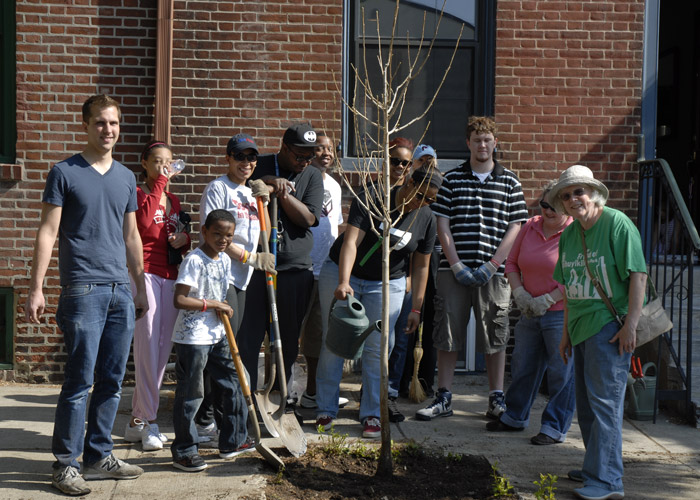 This tree was the very first one that got itself planted Saturday morning by these tree-planting students; immediately after posing for this tree-planting graduation photo, the class split up into crews and planted about fifteen more trees around the neighborhood, as part of Philadelphia's Million Trees Project.
This tree was the very first one that got itself planted Saturday morning by these tree-planting students; immediately after posing for this tree-planting graduation photo, the class split up into crews and planted about fifteen more trees around the neighborhood, as part of Philadelphia's Million Trees Project.
This is a gingko tree, apparently the Fairmount Park gingko variety developed in Philadelphia specifically for urban settings. It has a more columnar growth habit than other gingkos, making it useful on narrow sidewalks or in other locations where there's little room for trees with spreading canopies. Frank Lloyd Wright was said to particularly admire the Fairmount Park gingkos, which he often utilized in landscaping around houses he designed in the Chicago area.
Jun 8, 2012
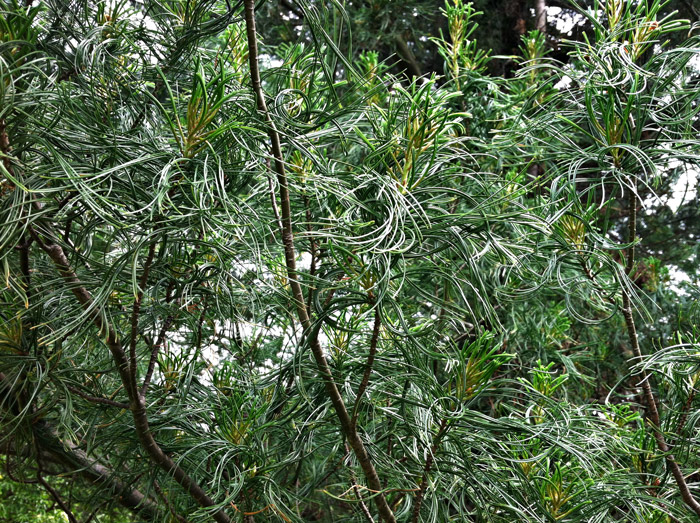 Curly needles? What's that about?
Curly needles? What's that about?
This is the only tree of its kind in the horticultural specimens area of Fairmount Park, and to the best of my recollection, it's the only one of its ilk I've ever noticed anywhere. The needles are long, curly, and soft. The tree is large, with an undistinguished, slightly disheveled, coniferous sort of habit.
The tree identification guides on the internet didn't work for me, so I'm turning to y'all: for all the tea in China, can you help me out on this?
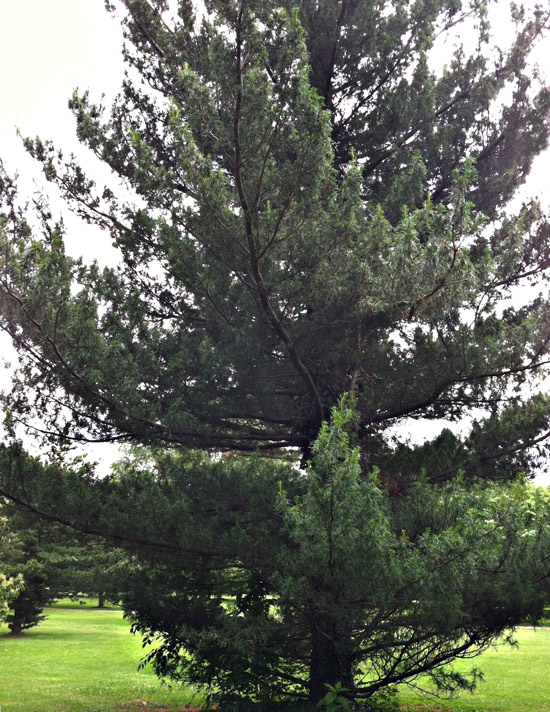
Jan 27, 2013
 One variety of redwood tree, the dawn redwood, is deciduous, dropping its needles in the fall. This same variety happens to be the only kind of redwood that will grow in the eastern United States; this example of a dawn redwood appears to be thriving in the Fairmount Park arboretum in Philadelphia.
One variety of redwood tree, the dawn redwood, is deciduous, dropping its needles in the fall. This same variety happens to be the only kind of redwood that will grow in the eastern United States; this example of a dawn redwood appears to be thriving in the Fairmount Park arboretum in Philadelphia.
Dawn redwoods may be the midgets of the redwood family; coast redwoods and giant sequoias in California reach heights greater than 300 feet, while dawn redwoods, though very fast-growing, may not get much taller than 200 feet. Their potential height is not known for certain, however, because the oldest dawn redwoods in America are only about 70 years old now, descended from a single specimen found in China in 1944. In California, coastal redwoods and giant sequoias live for hundreds or even thousands of years.
Dawn redwoods were known to scientists from the fossil record long before the live specimen was found in China; they were assumed to be extinct. Fossilized dawn redwoods dating back to the Eocene, 50 or more million years ago, have been found in many parts of the world, including Greenland and islands in the Arctic Ocean, which had a tropical climate at the time. It is believed that the trees became deciduous in response to the extreme light-dark cycle of their high-latitude habitat; even though winters were not cold, they were very dark, rendering leaves or needles useless.
The young man in the tree, of course, is Hank, who is a college student studying ecology and climate change.
Oct 24, 2013
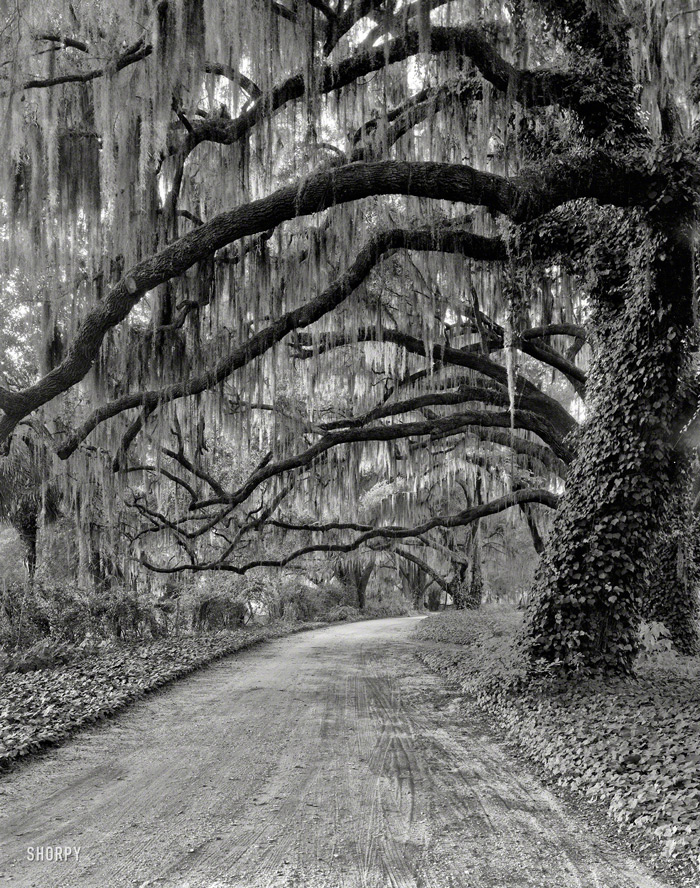 In 1940, when photographer Frances Benjamin Johnston visited Wormsloe Plantation near Savannah, Georgia, the approach looked much as it had in antebellum times. Twentieth-century horseless carriages left different tracks in the dirt of the mile-and-a-half-long driveway, but intervening decades had done nothing to change the overall effect of oak and moss and ivy.
In 1940, when photographer Frances Benjamin Johnston visited Wormsloe Plantation near Savannah, Georgia, the approach looked much as it had in antebellum times. Twentieth-century horseless carriages left different tracks in the dirt of the mile-and-a-half-long driveway, but intervening decades had done nothing to change the overall effect of oak and moss and ivy.
The original plantation house, however, built in the mid-eighteenth century out of tabby–cement made primarily of crushed oyster shells–crumbled away long ago. A nineteenth-century replacement house is still controlled by descendants of the family that built the place, though most of the acreage was deeded over to the state during the Depression.
In the early years of the twentieth century, the family name was changed from Jones to DeRenne, and the spelling of the plantation was changed from Wormslow to Wormsloe. They must have had their reasons.
Jan 22, 2014
 On a day like this, all the neighborhood cats stayed indoors snoozing by the heater.
On a day like this, all the neighborhood cats stayed indoors snoozing by the heater.
Feb 11, 2014
Nov 18, 2014
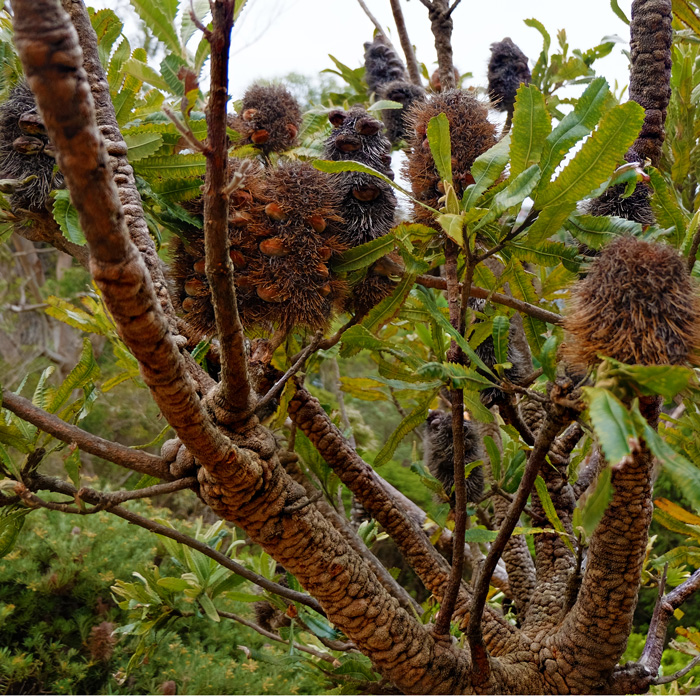 The gnarled little trees called wallum banksia thrive in the sandy heathlands along Australia's east coast, from Queensland down into northern New South Wales around Sydney. Tall spikes of yellow-green flowers linger for months on the branches, drying out and turning brown and then gray; the knobby fruits–seed follicles–may hang on the plant indefinitely, at least until a brush fire sweeps across the countryside, which is something that happens there about every seven to twelve years.
The gnarled little trees called wallum banksia thrive in the sandy heathlands along Australia's east coast, from Queensland down into northern New South Wales around Sydney. Tall spikes of yellow-green flowers linger for months on the branches, drying out and turning brown and then gray; the knobby fruits–seed follicles–may hang on the plant indefinitely, at least until a brush fire sweeps across the countryside, which is something that happens there about every seven to twelve years.
Wallum banksia are not harmed by fire, nor by salt spray or nutrient-starved sandy soil or extended drought. The species has evolved to thrive in extremely harsh conditions, in a habitat which, like the species itself, is known as wallum.
Fire may burn up the leaves and branches, but it also pops open the seed follicles, allowing new little wallum banksia to sprout up all around the old ones. Also, the roots often push up new growth after a fire, helping the species reclaim the territory from other opportunistic seeds that might be trying to spread thereabouts.
The specimen pictured here is not in Australia at all, but in the Australian garden area of Wellington Botanic Gardens in New Zealand. The climate in almost all of New Zealand is cooler and far moister than in most parts of Australia, and wallum banksia does not grow naturally in New Zealand. In fact, it is said that the healthiest, largest, fastest-growing specimens are in dry, sunny, fire-prone locations with poor soil comprised mostly of sand.
Feb 15, 2015
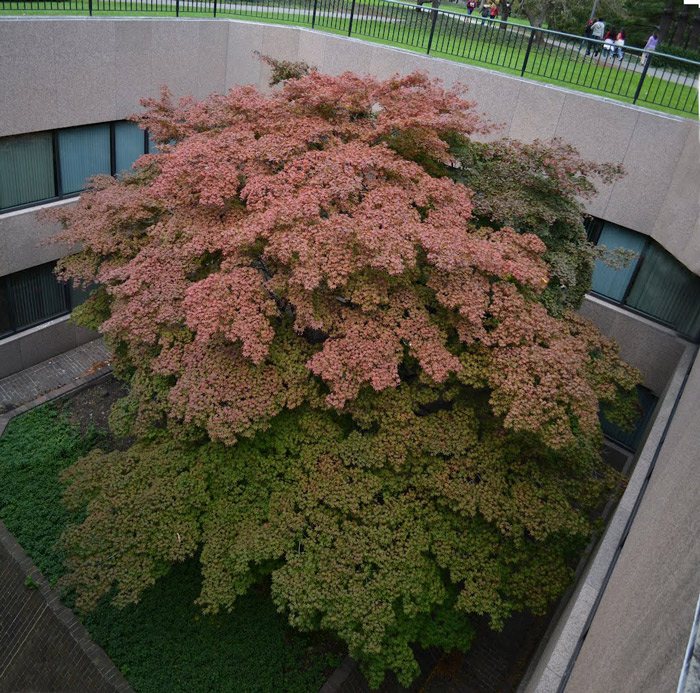 In Harvard Yard, Cambridge, MA. Surely buried in snow at the moment.
In Harvard Yard, Cambridge, MA. Surely buried in snow at the moment.
Apr 11, 2015
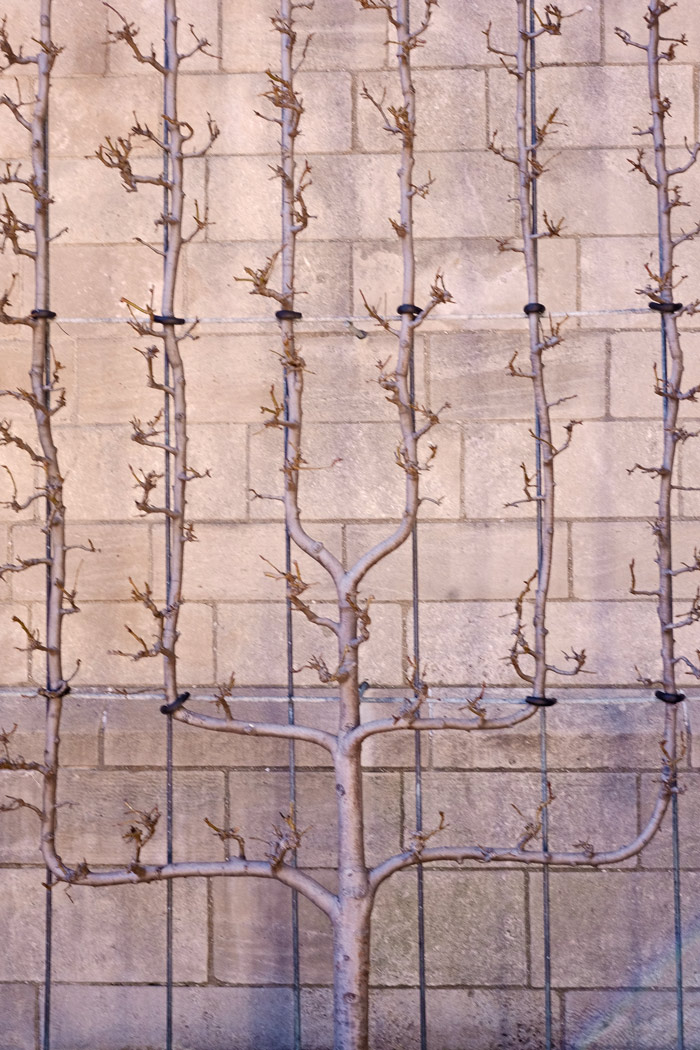 One week ago, on a chilly but sunny New York afternoon, this espaliered pear tree in the Cloisters medieval garden was trying really, really hard to leaf out.
One week ago, on a chilly but sunny New York afternoon, this espaliered pear tree in the Cloisters medieval garden was trying really, really hard to leaf out.
Apr 30, 2016
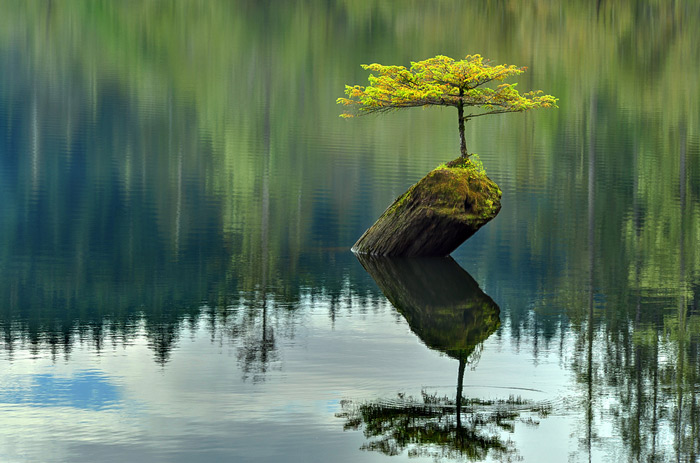 In the middle of Fairy Lake, near the remote town of Port Renfew on the west coast of Canada's Vancouver Island, sits an old Douglas fir log, partly rotting where it's exposed to the air but mostly submerged in the still waters of the lake.
In the middle of Fairy Lake, near the remote town of Port Renfew on the west coast of Canada's Vancouver Island, sits an old Douglas fir log, partly rotting where it's exposed to the air but mostly submerged in the still waters of the lake.
On the rotten tip of the log is another Douglas fir tree, alive and growing but not exactly flourishing; its roots struggle to maintain purchase on the log and to pull nutrients from the rotting wood. Without soil to grow in, it is stunted, a natural bonsai tree, starved but somehow much more interesting and impressive than all the millions of ordinary fir trees growing fat and happy where trees are meant to grow.
Jan 17, 2018
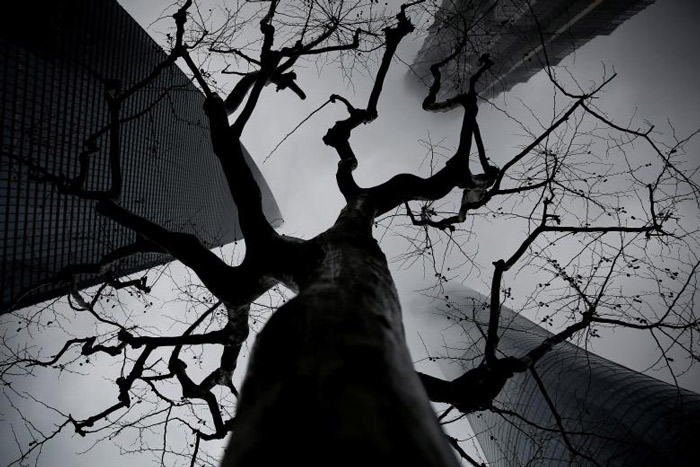 Fog swallows the tips of new skyscrapers around an old tree in the Pudong Financial District of Shanghai.
Fog swallows the tips of new skyscrapers around an old tree in the Pudong Financial District of Shanghai.